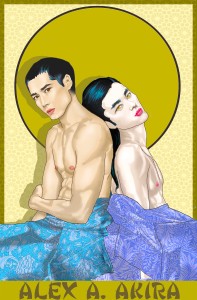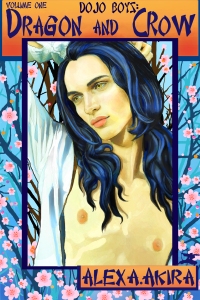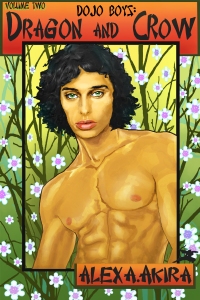
 Title: Dragon and Crow – Deluxe 2 Volume Set
Title: Dragon and Crow – Deluxe 2 Volume Set
Series: Dojo Boys
Author: Alex A Akira
Publisher: Triple A Press
Cover Artist: Alex A Akira
Length: Volume 1 – 275 Pages; Volume 2 – 390 Pages
Release Date: 25th May, 2015
Blurb: Twenty-three-year-old, Native American, Michael Black’s well-ordered life is disrupted one evening when he is ambushed at the dojo he frequents by a mysterious Japanese youth who goes by the name of Kiyoshi.
Soon circumstances have the gorgeous teen staying with Michael at his apartment. The gifted nineteen-year-old is an intriguing mix of angst, innocence and crafty intelligence, but Michael is honor bound by a promise to his sensei to keep his distance. Michael tries to keep his desire in check, but what can he do if the exquisite teen keeps kissing him?
Volume two finds Michael in deep water when, in trying to help Kiyoshi, he is persuaded by his sensei to participate in a joint government undercover operation to bring down a Yakuza lord.
Before long Michael is immersed in beautiful men, martial arts and espionage all to gain the trust and love of Kiyoshi. Secrets, lies, sex and action combine in this racy, romantic, adventure of two men, Michael Black and his sensei, Ichiro Kimura, navigating a dangerous path for true love.
YAOI, M/M ROMANCE AND THE HISTORY OF THE BISHOUNEN
 While researching my yaoi romance novel, Dojo Boys: Dragon & Crow, I was as astounded at the depth of history relating to romanticized sex between males, which led to Japan’s current yaoi empire. I was also struck by how the development of yaoi and male-male romance in the East and West appeared to reflect the liberation of women in both cultures. What is now a rapidly growing group of females who read, write and relish in romantic tales of homoerotic sex between men, may in fact have started as women’s quiet rebellion against each society’s antiquated ideals of females. The Japanese history of the bishōunen and of romanticized sex between men who are not necessarily homosexual is vast and during the five- week blog hop of Dojo Boys: Dragon and Crow, I’ll be sharing some of what I learned through a series of posts. I hope you’ll join me on this fascinating journey.
While researching my yaoi romance novel, Dojo Boys: Dragon & Crow, I was as astounded at the depth of history relating to romanticized sex between males, which led to Japan’s current yaoi empire. I was also struck by how the development of yaoi and male-male romance in the East and West appeared to reflect the liberation of women in both cultures. What is now a rapidly growing group of females who read, write and relish in romantic tales of homoerotic sex between men, may in fact have started as women’s quiet rebellion against each society’s antiquated ideals of females. The Japanese history of the bishōunen and of romanticized sex between men who are not necessarily homosexual is vast and during the five- week blog hop of Dojo Boys: Dragon and Crow, I’ll be sharing some of what I learned through a series of posts. I hope you’ll join me on this fascinating journey.
PART FIVE: GENROKU AND THE FLOATING WORLD
In my last post I revealed the bishounen’s post-war survival skills as a kabuki actor and male prostitute in the pleasure districts of 17th century Kyoto, the start of the Edo period. I now expand on that topic and reflect on the vivid atmosphere of the golden age of Edo known as Genroku (1688-1704). This Japanese “Renaissance” birthed a flourishing middle class and a colorful period of excessive earthly pleasure before inflation and the import of Western ideals, brought forth the Meiji Restoration, the coming of which introduced new ideas about civilization and morality … which included suppressing the rampant predilection for male/male sex in Japan.
During the Edo period, (1603-1868), Japan was ruled by shoguns of the Tokugawa clan in a military based government and the village of Edo became the rapidly expanding capital of Japan. With the influx of laborers, males made up nearly seventy percent of the city’s population and the practice of shudo and nanshoku too, expanded. Society was divided into four social classes, with the ruling samurai class at the top and the merchant class at the bottom. While deprived of their political influence, the merchant class benefited greatly from the expanding economy and began to frequent the pleasure districts, collect artwork, and engage in other pursuits, which previously had been well beyond their financial means.
While the nobles and samurai still considered moneylenders, shopkeepers and tradesmen to be a lowly class, with the expansion of the capital came a prosperous market for goods, skilled workers and entertainment facilities. Opportunities to increase one’s monetary worth, if not that of one’s class, were abundance and the townsmen became a powerful middle class known as chõnin. With the prospering of trade, merchants formed cartels and grew wealthier still. Shops, restaurants, teahouses, gambling parlors and brothels, sprang up, as did pre-modern manufacturing. With the influx of mass production townsmen began to compete with each other by increasing the luxuries they offered. Silks, brocades, swords, lacquered screens, carpets, tea, tobacco, paintings, paper, medicine, jewels, and all manner of entertainment and sexual extravagance could be purchased in the growing cities of Edo, Kyoto and Osaka. The bishounen flourished in this environment and were often the reaper of many rewards by way of gifts from vying patrons. Bishounen beauty was celebrated in music, fashion, theatre, and publication and in the popular shunga (erotic art) ukiyo-e, woodblock images of the Floating World.
The Floating World refers to the urban, pleasure-seeking culture developed in walled-citadel of love known as Yoshiwara. This licensed red-light district in Edo was established in 1618, with similar districts being founded in Kyoto and Osaka. For two hundred years a fantastic and complex love cult of pleasure and prostitution would flourish there, leaving its mark on all subsequent Japanese culture. In 1666 writer Asai Ryōi penned the celebrated book Ukiyo Monogatari (Tales of the Floating World); he describes the atmosphere of the Floating World in this lyrical passage:
“living only for the moment, savoring the moon, the snow, the cherry blossoms, and the maple leaves, singing songs, drinking sake, and diverting oneself just in floating, unconcerned by the prospect of imminent poverty, buoyant and carefree, like a gourd carried along with the river current: this is what we call ukiyo.”
Nanshoku received its greatest flowering in literature and the arts during the Genroku period, and the public eagerly consumed these previously rare gifts, which became available in abundance. Japan’s most famous writers and artists were at the peak of their expressive powers. Ihara Saikaku introduced the realistic novel to Japanese fiction with his The Great Mirror of Male Love: the Custom of Boy Love in Our Land. Chikamatsu Monzaemon has been called Japan’s Shakespeare and used nanshoku in his famous play Love Suicides on the Eve of the Kōshin Festival. Shunga artist extraordinaire, Kitagawa Utamaro produced exquisite shunga depicting nanshoku. The expressions he gave bishounen engaging in acts lovemaking are breathtakingly intimate.
Wakashu, bishounen, and both male and female prostitutes were revered and regaled through the art, poetry and written publications, which sprang from the Genroku period. In addition to the tanrokubon, the clever orange green illustrated books of the mid 1600’s, woodblock imagery became increasingly popular in shunga and in the kanazōshi, a type of printed book that was produced primarily in Kyoto between 1600 and 1680. Ukiyozōshi, books with erotic illustrations and stories depicting the lifestyle of the floating world, became the first major genre of popular Japanese fiction. Bishounen, male prostitutes and wakashu kabuki actors, likenesses could be found in concert with stories depicting shudo and nanshoku in commercially published ukiyozōshi. I would say these works were perhaps a forerunner to BL, or the modern boys love manga.
Yoshiwara, itself, continued to become a strong commercial area. The fashion in the walled town changed frequently, creating a great demand for merchants and artisans and a great runway for the bishounen seeking patronage. Fashion was so important in Yoshiwara that it frequently dictated the fashion trends for the rest of Japan. The ultimate in stylish arrivals to Yoshiwara was to arrive, dressed to the nines on the back of a splendid horse. A young mounted samurai in white leather trousers, a white silk kimono, his gleaming ebony hair pulled up and his swords sheathed in white, mounted upon a magnificent white steed horse made for an impressive sight to his colorful silk-swathed wakashu lover, and inspired artists and writers alike.
With the new wealth afforded them, townsmen, samurai, artists and bishounen all relished in the excessive delights and the devil-may-care atmosphere of wonder and excitement that the Genroku and Edo period offered … blissfully ignoring the developing European and Western civilization until Commodore Matthew Perry steered his fleet of modern steam-powered warships into Uraga Bay in 1853.
Join me for my next post SHUDŌ OR HOMOSEXUALITY where I investigate the Western civilization’s influence on the long embraced tradition of male/male love in Japan.
 Michael groped for the light switch, a smile of triumph playing at his lips. Damn, I did it! I beat him! Flicking the switch, he turned, eager to view his skilled opponent and to bask in the accolades that he was sure to receive from Sensei Kimura.
Michael groped for the light switch, a smile of triumph playing at his lips. Damn, I did it! I beat him! Flicking the switch, he turned, eager to view his skilled opponent and to bask in the accolades that he was sure to receive from Sensei Kimura.
His triumph descended to dismay in a flash. Who the hell is this?
A slight figure lay crumpled at the center of the practice room. Cautiously approaching the limp form, Michael’s heart sank even further. Lying unconscious on the gleaming bamboo floor was a Japanese boy. He looked to be about five-foot-seven, was very pale, and quite young.
“A kid? I beat up a kid?” Quickening his pace, Michael knelt beside the slim figure. Jesus, he’s like fourteen, fifteen? Beautiful. He looks like Ichiro. Better, actually, Michael admitted, surprised at his internal betrayal of his long-held crush on his sensei. He continued to stare down at the slight, fragile boy, eyeing the long blue-black hair that trailed sensuously around the figure’s unfamiliar gray karategi.
Who the hell is he? Why would they have me beat up a kid for my test? Puzzled, he glanced around the room, noting that he and the boy were alone. Ignoring his impending alarm, he gazed back to the unconscious figure.
 The youth’s face was truly beautiful. Michael’s inner artist drank in the smooth, pearly skin, the long, sooty lashes, and the pale apricot color blushed across the boy’s delicate cheekbones. God… An aching hunger preceded the lurch of Michael’s cock, which nudged his lower abdomen telegraphing its interest. Get it together. He’s like … twelve! Suddenly realizing that the boy showed no sign of regaining consciousness, Michael snapped from his trance and shook his opponent’s shoulder.
The youth’s face was truly beautiful. Michael’s inner artist drank in the smooth, pearly skin, the long, sooty lashes, and the pale apricot color blushed across the boy’s delicate cheekbones. God… An aching hunger preceded the lurch of Michael’s cock, which nudged his lower abdomen telegraphing its interest. Get it together. He’s like … twelve! Suddenly realizing that the boy showed no sign of regaining consciousness, Michael snapped from his trance and shook his opponent’s shoulder.
“Hey!” He leaned over the placid body, hand stretching toward the longish neck for a pulse. The telltale thump throbbed beneath his fingers, but his proximity to the boy’s face had him pausing to stare at the youth’s sculpted lips. Christ, get away from him before you do something you’ll regret. Frowning, he started to shift upright when a relentless grip clutched his hair.
Caught off guard, Michael fumbled helplessly as his head was tugged abruptly toward the face beneath him. The beautiful mouth claimed his lips, stealing his breath and muffling his gasp as a hot tongue invaded his mouth. The agile member eagerly caressed its counterpart, igniting Michael’s senses. The tantalizing scent of ripe apricots surrounded him, dizzying him with sensual promises, and urging him to surrender.

Alex A. Akira is the author of the yaoi romance series Dojo Boys, racy tales of young, male martial artists navigating some unorthodox and adventurous paths to find love. The Deluxe two-volume box set of Dojo Boys: Dragon and Crow are available at Amazon:
Author Links –
FACEBOOK: https://www.facebook.com/pages/Dojo-Boys-Dragon-Crow/1586470108305850
WEBSITE: http://www.alexaakira.org/
TWITTER: https://twitter.com/AlexAAkira
Google Plus: https://plus.google.com/u/0/103196749872035740632/posts/p/pub
Three Winners get $25 Amazon Gift Card each.
Seven Runners-up get a free e-copy of the prequel to this series – DOJO BOYS: The First Misunderstanding.
Enter the Rafflecopter NOW.
June 1: Fangirl Moments and My Two Cents
June 2: Andrew Q. Gordon
June 3: A Celebration of Books
June 4: Joyfully Jay
June 5: Elisa – My reviews and Ramblings
June 7: Wicked Faeries Tales And Reviews
June 8: The Novel Approach
June 9: Drops of Ink || LeAnn’s Book Reviews
June 10: Eyes on Books
June 11: Prism Book Alliance
June 12: Nephy’s World
June 14: Love Bytes Reviews
June 15: Cia’s Stories
June 16: The Purple Rose Tea House
June 17: MM Good Book Reviews
June 18: Nessa’s Book Reviews
June 19: Scattered Thoughts & Rogue Words
June 21: Rainbow Gold Reviews
June 22: Man2ManTastic
June 23: The Fuzzy, Fuzzy World of Chris T. Kat
June 24: Lynley Wayne – Wordsmith Wednesday
June 25: Diverse Reader
June 26: Mickie B. Ashling
June 28: Bayou Book Junkie
June 29: BFD Book Blog
June 30: Bike Book Reviews
July 1: Multitasking Mommas Book Reviews
July 2: Nautical Star Books || Divine Magazine
July 3: Gay.Guy.Reading And Friends






Hmmmmm…I’ve decided I want!
[…] Read Part 5 of Alex A Akira’s commentary on the relationship between Yaoi, m/mromance and Japanese culture at Love Bytes […]
great blog post ..book sounds great